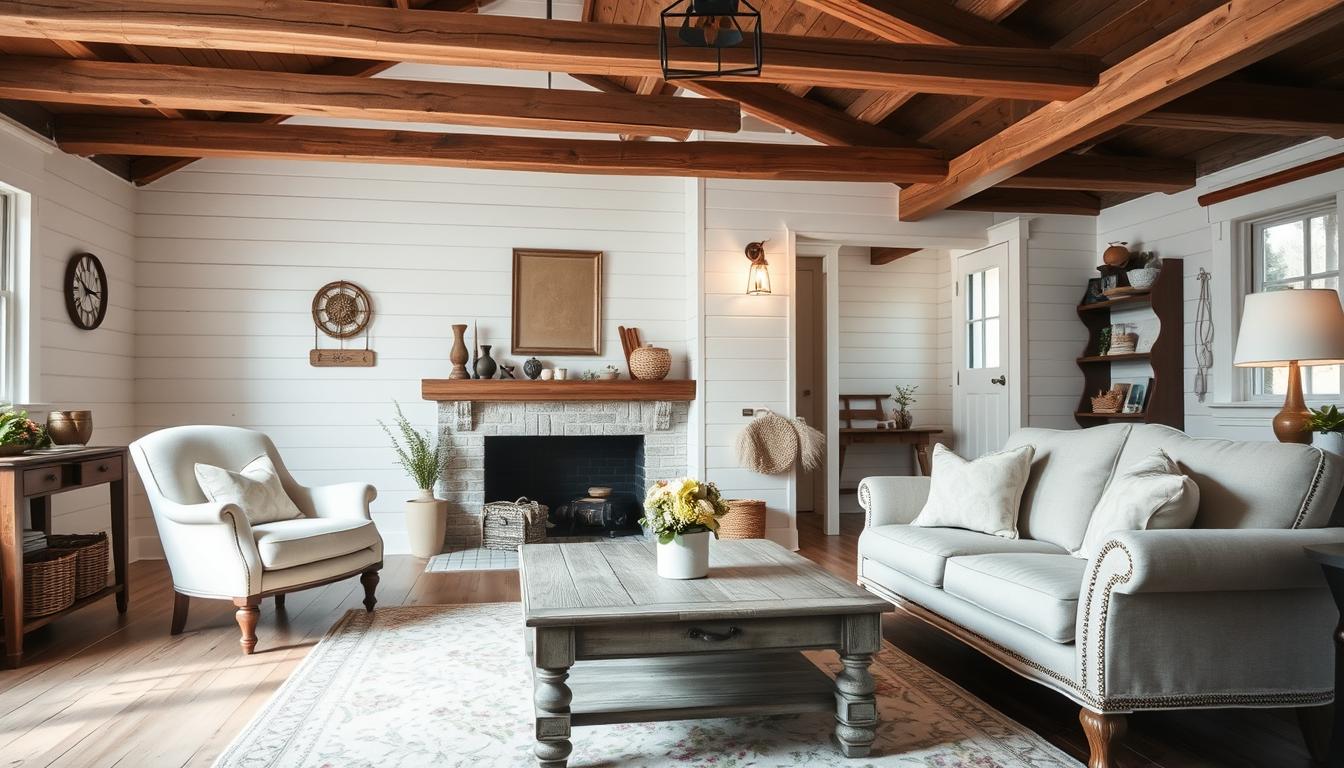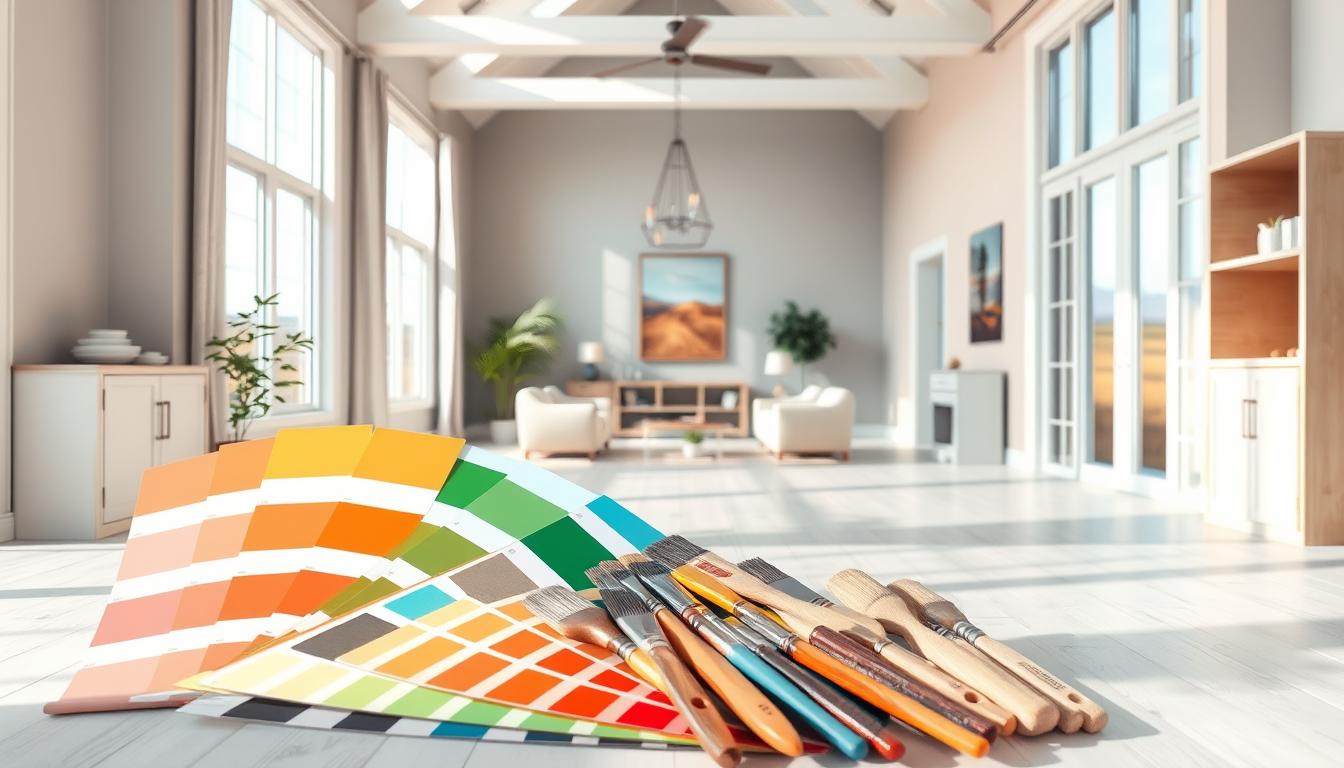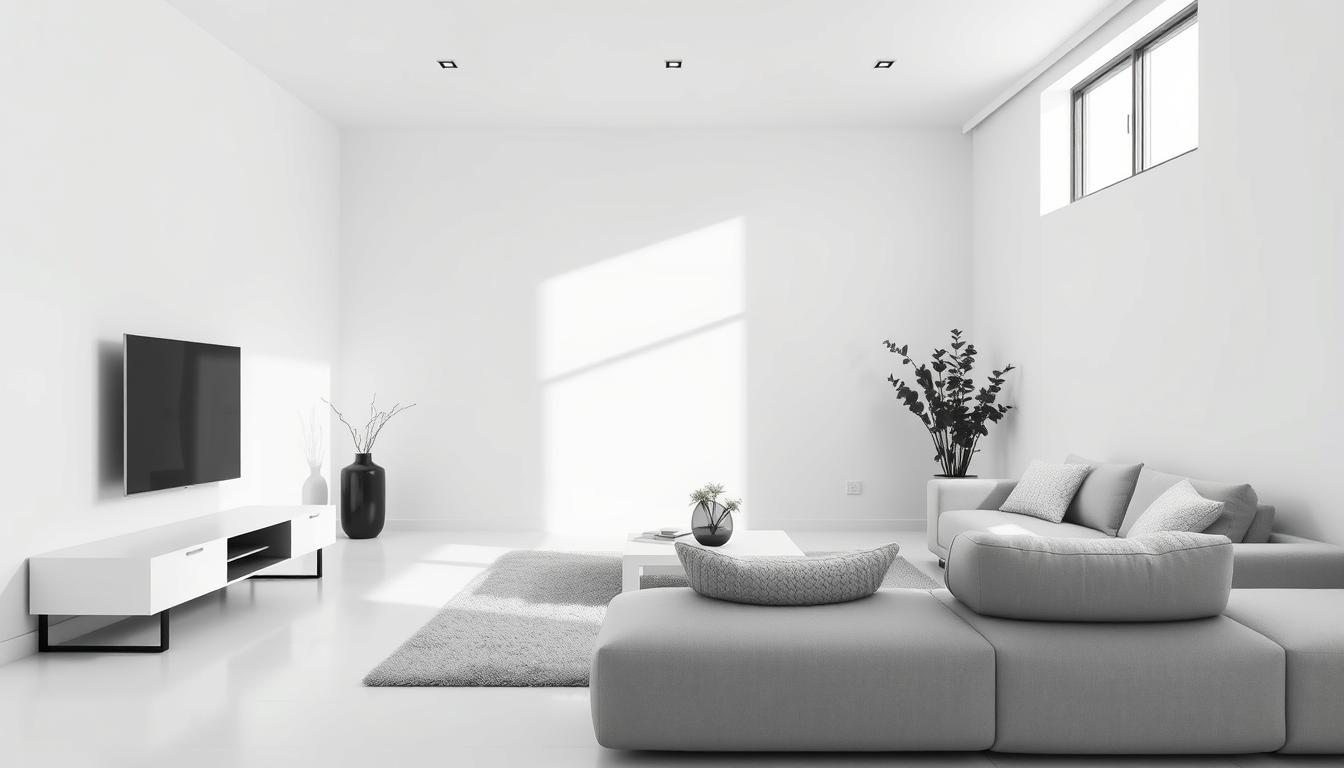Did you know over 10,000 people in the U.S. live in tiny homes? They choose a minimalist and sustainable lifestyle. We’re fascinated by the french country home interior, known for its rustic charm and cozy feel.
Creating tiny home interiors needs creativity and smart planning. We aim to use space wisely and keep it welcoming. Our guide offers expert advice on making small homes beautiful and useful. For more, see our detailed guide on designing tiny home interiors.
Key Takeaways
- Maximize natural light to create a sense of spaciousness
- Opt for multi-functional furniture to reduce clutter
- Use a neutral color palette to create a sense of calm
- Incorporate storage solutions to keep belongings organized
- Consider the flow of your space to enhance functionality
Understanding the Essence of Tiny Living
Exploring tiny homes reveals their unique appeal. They offer many benefits, like less environmental harm and lower costs. We’ll look at how tiny homes simplify life and boost efficiency.
Benefits of Choosing a Tiny Home
Choosing a tiny home brings many perks. For one, reduced energy consumption saves money on bills. Tiny homes use less power, which is good for the planet and your wallet.
Living small also means less clutter. This leads to a more organized and peaceful home. It’s a big plus for those who value simplicity.
Financially, tiny homes are a smart choice. They cost less to build and maintain. This makes them an affordable housing option.
Environmental Impact of Tiny Living
Tiny homes are better for the environment. They use fewer resources and create less waste. This makes them a greener choice than traditional homes.
Many tiny home owners also use eco-friendly practices. They might choose renewable energy or recycle more. This helps reduce their environmental impact even more.
Living in a tiny home encourages eco-friendly habits. The limited space means less waste. It’s a step towards a more sustainable future.
Key Principles of Tiny Home Interior Design
Tiny home interior design is a mix of beauty and usefulness. It’s all about making the most of a small space. This means thinking about how to use every inch wisely.
One big challenge is making the space feel big while keeping it useful. Using furniture that does more than one thing helps a lot. For example, a storage ottoman or a bed that folds up can save space.
Maximizing Space with Functionality
To make the most of a tiny home, planning is key. Think about where to put things to avoid clutter. Using shelves and cabinets on walls can make the floor look bigger.
Choosing furniture that can change its use is smart. A table that’s also a desk or a sofa that turns into a bed is great. It saves space and makes the home more useful.
| Furniture Piece | Primary Function | Secondary Function |
|---|---|---|
| Murphy Bed | Sleeping | Wall Space for Other Uses |
| Storage Ottoman | Seating | Storage for Linens or Toys |
| Dining Table with Workspace | Dining | Workspace for Remote Work |
Balancing Aesthetics and Utility
Looks matter too in tiny home design. Adding touches of elegant french country design can make the space feel fancy. Think soft colors and fancy furniture.
To blend looks and function, use light colors on walls and floors. This makes the space feel bigger. Also, mirrors can make the room look even larger by reflecting light.
By mixing beauty with usefulness, we can make a tiny home that’s both lovely and practical. Whether you like french country style or something more modern, finding the right balance is key.
Selecting the Right Color Palette
The color scheme of your tiny home greatly affects its feel. A good choice can make it seem bigger and more welcoming.
In tiny homes, colors are key. They can change how we see space. It’s vital to pick colors that match your design goals.
Impact of Colors on Perception of Space
Colors can make a room look bigger or smaller. Light colors reflect light, making a space feel open. Dark colors absorb light, making a room cozy but smaller.
To make a space seem larger, use soft, light colors. These colors:
- Reflect natural light
- Create a sense of continuity
- Make the space feel more expansive
But, don’t forget to add warm accents to your tiny home. They add character and warmth.
Popular Color Schemes for Tiny Homes
The vintage French country style is a great inspiration. It uses soft, muted tones and warm colors. This creates a cozy, inviting feel.
“The key to a successful vintage French country style is in the subtlety of its color palette, which often features soft whites, creamy yellows, and gentle blues.”
Other popular schemes include:
| Color Scheme | Description | Effect on Space |
|---|---|---|
| Monochromatic | Using different shades of the same color | Creates a sense of continuity and can make the space feel larger |
| Complementary | Pairing colors opposite each other on the color wheel | Adds visual interest and can create a sense of energy |
| Analogous | Using colors next to each other on the color wheel | Creates a harmonious and soothing palette |
Think about your tiny home’s natural light and your style when picking colors. This will help you achieve the look you want.
Choosing the right colors can make your tiny home feel both cozy and spacious. It’s all about the right palette.
Smart Furniture Choices for Tiny Spaces
In tiny homes, the furniture you pick is key. It must be both functional and stylish. We draw inspiration from charming cottage interiors to make our tiny homes cozy and efficient.
Multi-functional Furniture Options
Choosing multi-functional furniture is smart for tiny homes. These pieces do more than one thing, cutting down on clutter. For instance, a storage ottoman can be a coffee table, a seat, and storage all in one.
Murphy beds are another great choice. They save space and let the area be used for other things when not in bed mode. Nesting tables and extendable dining tables also save space and are versatile.
Tips for Choosing Scaled-Down Pieces
When picking furniture for a tiny home, go for pieces that are the right size. Look for furniture with simple designs and little bulk to make the space feel open. Make sure the furniture fits well with the room and other items.
- Opt for sofas and chairs with legs rather than bulky bases to create a sense of airiness.
- Choose furniture with built-in storage to keep clutter at bay.
- Consider the functionality of each piece and how it contributes to the overall livability of the space.
By picking furniture that’s both functional and stylish, we can make our tiny homes feel big and welcoming. It’s like a charming cottage.
Creating Separate Spaces with Design
The secret to cozy tiny living is making different areas in a small space. In tiny homes, the goal is to design spots that do more than one thing without feeling too tight or messy.
Open Concept Versus Defined Areas
Choosing between an open-concept layout or separate areas is a big decision for tiny home design. Open-concept living makes a tiny home feel bigger and encourages people to interact. Yet, it might lack privacy and clear spaces for different activities.
Defined areas, on the other hand, offer the privacy and space needed for various tasks, like cooking, working, or relaxing. This is super helpful in tiny homes where people often spend a lot of time at home.
Utilizing Room Dividers Effectively
Room dividers are a smart way to make separate spaces in a tiny home. They can divide areas without needing permanent walls, keeping the space open. Traditional French country homes use room dividers or curtains to make snug, private spots in big rooms.
When picking room dividers, think about the material, size, and style to match your tiny home’s look. For example, sliding panels or curtains are easy to put up and come in many materials like wood, fabric, or glass. This adds texture and interest to your space.
By carefully using room dividers and balancing open-concept and defined areas, you can make your tiny home both functional and cozy.
Storage Solutions for Tiny Homes
Effective storage is key in tiny homes, where space is limited. Keeping things tidy is vital for a cozy, welcoming feel.
We can find many storage solutions that are both useful and look good. Marie Kondo said, “The purpose of a home is to create a space that brings joy and comfort.”
“A cluttered space is a cluttered mind,”
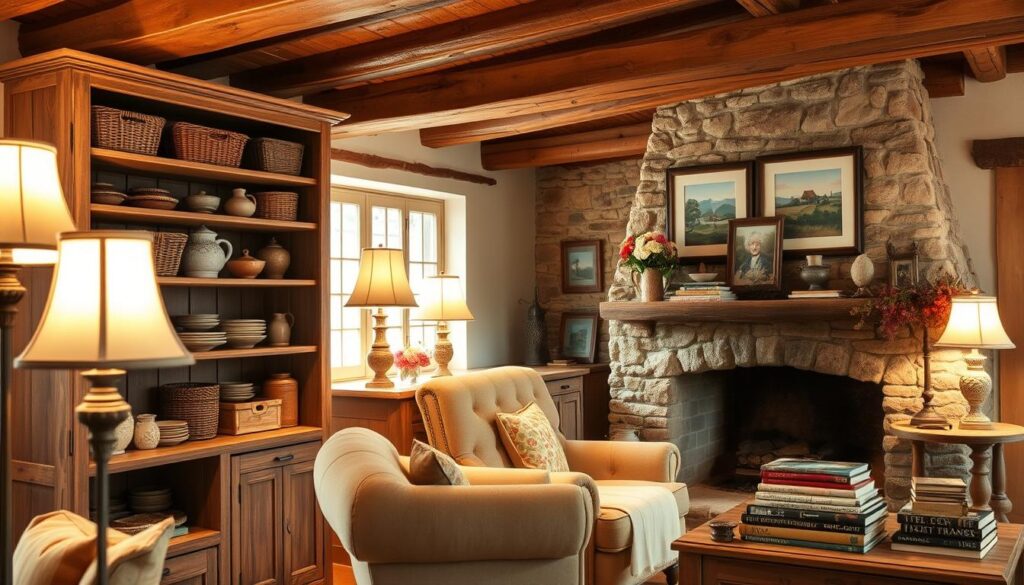
Innovative Storage Ideas
Innovative storage ideas can greatly improve tiny homes. Using multi-functional furniture is a smart move. For instance, a storage ottoman can be a seat and a place to store items like linens or toys.
Hidden storage compartments are another great idea. Think under-stair storage or secret drawers. These spots help keep things tidy while looking neat and organized.
Under-bed and Vertical Storage Options
Under-bed storage is a fantastic way to use space in tiny homes. Bed risers or storage bins can hold items like out-of-season clothes, bedding, or luggage. This keeps the floor clear and makes the space feel bigger.
Vertical storage, like wall-mounted shelves or units, is also very effective. It uses the vertical space to store things like books, decorations, or kitchenware. This keeps the floor clutter-free and makes things easy to reach.
Using stackable containers or baskets is another smart move. They can hold various items, from toys and linens to kitchen tools and cleaning supplies.
By using these storage solutions, we can make our tiny home cozy and organized. This way, we can enjoy a more relaxed and tidy living space.
Lighting Strategies for Tiny Interiors
Lighting is key in tiny homes. It’s not just about light; it’s about making the space feel bigger and more inviting.
We’ll look at two important lighting aspects: natural light and layering light sources. These strategies can greatly enhance your tiny home’s livability and charm.
Importance of Natural Light
Natural light is precious in tiny homes. It cuts down on the need for artificial light and makes spaces feel open and spacious. Here are some tips to maximize natural light:
- Use sheer curtains or blinds to let sunlight in while keeping things private.
- Place mirrors opposite windows to reflect light deeper into the room.
- Ensure windows are clear of furniture or heavy drapery for better sunlight.
Using these tips can significantly brighten and air out your tiny home. For example, a small living room with a big window and minimal window treatments can seem much larger.
Layering Light Sources for Ambiance
Layering light sources creates a cozy and inviting atmosphere in tiny homes. This involves mixing overhead lighting, table lamps, and floor lamps for a layered look. French provincial interior design is a great inspiration for this.
To achieve layered lighting, consider the following:
| Light Source | Purpose | Example |
|---|---|---|
| Overhead Lighting | General Illumination | Recessed ceiling lights |
| Table Lamps | Task Lighting | Lamps on side tables or desks |
| Floor Lamps | Accent Lighting | Lamps placed in corners or beside furniture |
By mixing these light sources, you can create a warm and inviting atmosphere in your tiny home. This not only looks good but also makes the space more functional.
In conclusion, good lighting strategies are essential for tiny interiors. By using natural light and layering artificial light, you can make your space feel larger, more welcoming, and beautifully designed.
Incorporating Personal Style in a Small Space
Our personal style can shine in a tiny home with the right choices. We need to balance our desire for self-expression with the space’s limitations.
To find this balance, we must be careful with our decor. Selecting a few meaningful pieces that show our personality is better than filling the space with too many items.
Choosing Decorative Elements Wisely
Decorating a tiny home requires choosing elements that reflect our style and make the space feel bigger. For example, french country home interior adds elegance and warmth. It uses soft colors, natural materials, and classic furniture for a cozy feel.
When picking decorative elements, consider these tips:
- Choose decor that serves more than one purpose.
- Make sure items fit the space well.
- Use a mix of textures and colors to add depth without clutter.
Rustic farmhouse decor also adds character to a tiny home. Elements like reclaimed wood, vintage fixtures, and earthy tones bring warmth and coziness.
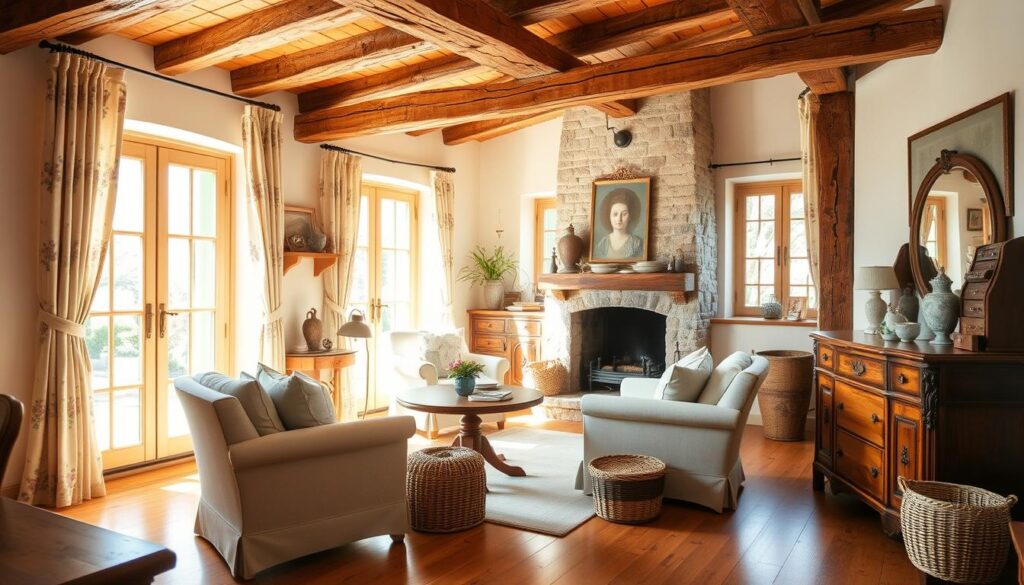
DIY Decor Ideas for Unique Touches
DIY decor projects are a great way to make our tiny home unique. They let us personalize our space and reduce waste by repurposing materials.
Here are some DIY decor ideas:
- Create a gallery wall with frames of different sizes and styles.
- Make decorative items from reclaimed or recycled materials.
- Upcycle old furniture with a fresh coat of paint or new hardware.
By carefully choosing decorative elements and doing DIY projects, we can make a tiny home that’s both functional and reflects our personal style.
Eco-friendly Design Choices
Tiny homes are great for living sustainably. They can be stylish and green, thanks to elegant French country design. Making eco-friendly choices in our tiny homes is key for a greener future.
Sustainable Materials and Finishes
Choosing the right materials is key for an eco-friendly tiny home. Vintage French country style uses reclaimed wood and natural textiles. These choices are good for the planet and add charm.
When picking materials, think about their source and how they’re made. Look for materials that are durable and don’t harm the environment.
Some green options include:
- Bamboo flooring, which is renewable and strong.
- Recycled glass countertops, which are unique and cut down on waste.
- Reclaimed wood for walls and furniture, adding warmth and history.
Energy Efficiency in Tiny Homes
Energy efficiency is vital in tiny homes. Using energy-saving appliances and smart tech can cut down energy use. Tiny homes also need less energy to heat and cool because they’re small.
To boost energy efficiency, consider:
- Installing solar panels for clean energy.
- Using eco-friendly insulation that works well.
- Choosing energy-efficient windows for natural light.
By choosing eco-friendly designs, we help the planet and create beautiful spaces. These spaces reflect the beauty of elegant French country design and the coziness of vintage French country style.
Designing for Comfort and Function
Creating a cozy tiny home needs careful planning. We can look to charming cottages and French country homes for inspiration. They help us make a snug and welcoming space.
Cozy Living Areas
Adding plush textiles and warm lighting makes a tiny living area cozy. French provincial design teaches us about classic elegance and subtle charm. These elements can transform a small space into a cozy retreat.
Ergonomics in Tiny Spaces
Designing a tiny home means focusing on ergonomics and practicality. Choosing furniture that serves more than one purpose is key. This way, we can make a space that looks good and works well.

